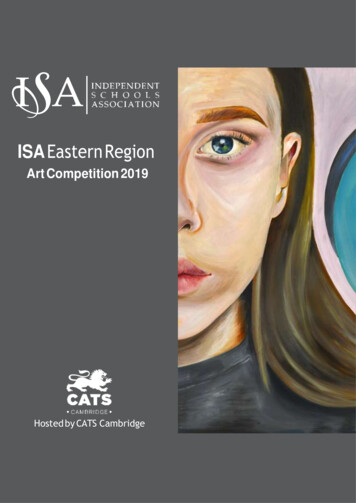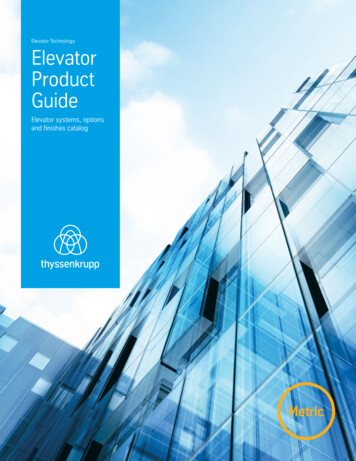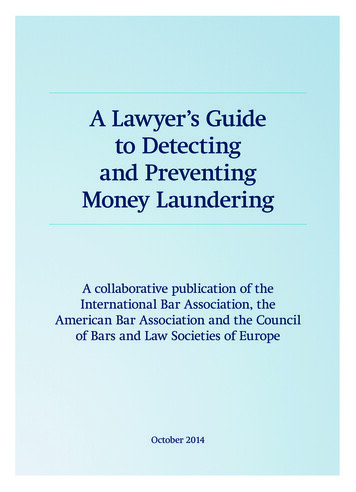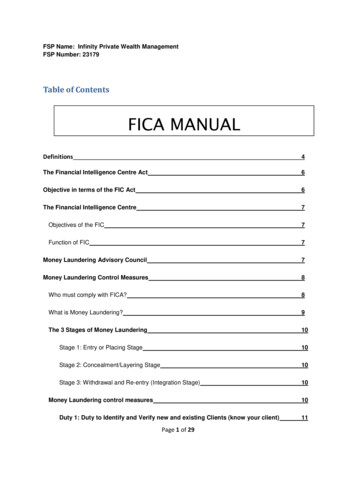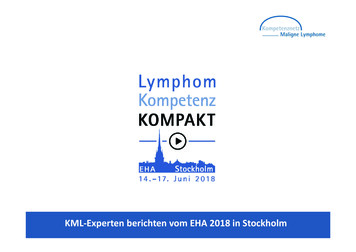
Transcription
docacademy.orgHe Named Me Malaladocacademy.orgdocsociety.orgKEY STAGE 3 & 4 — ENGLISHHE NAMED MEMALALAKS3-4Page 01 docsociety.org Lesson Plan 2018
docacademy.orgHe Named Me MalalaThis six-lesson unit is rooted in exploring the themes and issuesportrayed in the He Named Me Malala documentary. The film introducesstudents to discussions surrounding unity, peace and education in theface of terrorism. These thought-provoking topics help to facilitatediscussion among students, introduce them to writer’s purpose, aswell as stimulate creative and non-fiction writing. These lessons aredesigned to help students develop their skills in English across keystages three, four and five.CONTENTSClick to jump to sectionOVERVIEWPage 02TEACHER’S NOTESPage 05LESSON 1INTRODUCING MALALA LESSON 2FINDING FORGIVENESSPage 06LESSON 3MALALA CAMPAIGNS IN NIGERIAPage 16LESSON 4MALALA’S VISIT TO A REFUGEE CAMPPage 20LESSON 5SPEAKING OUTPage 24LESSON 6Page 02UNITED NATIONS docsociety.org Lesson Plan 2018Page 12Page 27
docacademy.orgHe Named Me MalalaNATIONAL CURRICULUM OBJECTIVES—— Lesson 1: Introducing MalalaLO: To use relevant evidence to support our inferences—— Lesson 2: Finding ForgivenessLO: To create a convincing narrative voice—— Lesson 3: Malala Campaigns in NigeriaLO: To contribute to a group discussion—— Lesson 4: Malala’s Visit to a Refugee CampLO: To clearly summarise and present information—— Lesson 5: Speaking OutLO: To craft language to persuade—— Lesson 6: United Nations LO: To shape language to suit purpose and audienceASSESSMENT OVERVIEWThe key assessment pieces in this unit are:—— Lesson—— Lesson—— Lesson—— Lesson—— Lesson—— Lesson1 Using relevant evidence to support our inferences2 Crafting language to develop a convincing narrative voice3 Using discussion to make a thoughtful and meaningful contribution4 Using non-fiction texts to explore a writer’s choices5 Crafting language to suit audience and purpose6 Adapting language to suit audience and purposeREADING ASSESSMENT OBJECTIVESKS3—— R1 Read a wide range of fiction and non-fiction.—— R2 Know the purpose, intended audience, and context of the writing and drawing on this tosupport comprehension.—— R3 Know how language, vocabulary choice, grammar, text structure and organisation, presentmeaning.KS4—— AO1 Identify and interpret explicit and implicit information and ideas.—— AO2 Explain, comment on and analyse how writers use language and structure to achieveeffects and influence readers.KS5—— AO1 Articulate informed, personal and creative responses to literary texts, using associatedconcepts and terminology, and coherent, accurate written expression.—— AO2 Analyse ways in which meanings are shaped in literary texts.Page 03 docsociety.org Lesson Plan 2018
docacademy.orgHe Named Me MalalaWRITING ASSESSMENT OBJECTIVESKS3—— W2 Consider how their writing reflects the audiences and purposes for which it is intended—— W2 Amend vocabulary, grammar and structure to their writing to improve its coherence andoverall effectiveness.—— W2 Pay attention to accurate grammar, punctuation and spelling.KS4—— AO5 Communicate clearly, effectively and imaginatively, selecting and adapting tone, style andregister for different forms, purposes and audiences.—— AO6 Use a range of vocabulary and sentence structures for clarity, purpose and effect withaccurate spelling and punctuation.SPOKEN LANGUAGEKS3—— S&L1 Use SE confidently in a range of formal and informal contexts.—— S&L1 Give short speeches and presentations, expressing their own ideas and keepingto the point—— S&L1 Participate in formal debates and structured discussions, summarising and/or buildingon what has been said.KS4—— AO7 Demonstrate presentation skills in a formal setting.—— AO8 Listen and respond appropriately to spoken language.—— AO9 Use spoken Standard English effectively in speeches and presentations.SCOTTISH CURRICULUMLiteracy (National 4) Unit1. Read and understand straightforward word-based texts.2. Listen to and understand straightforward spoken communication.3. Write straightforward technically accurate texts.4. Talk to communicate, as appropriate to audience and purpose.Page 04 docsociety.org Lesson Plan 2018
docacademy.orgHe Named Me MalalaHe Named Me MalalaDirected by Davis Guggenheimwww.malala.orgShort SynopsisWhen 11-year-old blogger Malala Yousafzai began detailing her experiences in the Swat Valley ofPakistan for the BBC, she had no idea what momentous changes were coming in her life. Her father,Ziauddin, a school founder and dedicated teacher, was outspoken in his belief that girls, including hisbeloved daughter, had a right to an education. As they continued to speak out against restrictionsimposed by extremists, Ziauddin received constant death threats, so many that he began to sleep indifferent places. But it was Malala who was almost killed, shot in the head by a gunman on her wayhome from school. Her survival and recovery have been little short of miraculous.Instead of being cowed by this horrific attack, Malala began to use the international attentionshe attracted to advocate for the cause of girls’ education worldwide. Through her speeches, herautobiography I Am Malala, the work the Malala Fund, and her travels to places where girls’ educationis in crisis, she has continued to focus on the effort to give all girls 12 years of safe, quality and freeeducation. The film He Named Me Malala both celebrates her dedication to girls’ education and givesthe viewer insight into her motivation. It begins with an animated portrayal of the teenage folk herofor whom Malala was named, Malalai of Maiwand, whose fearlessness and love of country turned thetide of battle for Afghan fighters. From those opening scenes, live action and animation tell the storyof Malala’s life before and after the attack. We see her at various times of her life: severely woundedin the hospital, teasing her brothers in her new home in England, giving a speech to the UnitedNations, teaching a class in Kenya, and more. Her efforts are ongoing and they are realised through herorganization, the Malala Fund, which empowers girls through quality secondary education to achievetheir potential and inspire positive change in their communities.ClipsAvailable from DocAcademy.orgClip 1 Background Of Malala Yousafzai’s StoryClip 2 Malala’s Prognosis and ForgivenessClip 3 Malala in NigeriaClip 4 Malala’s Visit to Syrian Refugee CampClip 5 Malala Speaks OutClip 6 Malala’s UN SpeechPage 05 docsociety.org Lesson Plan 2018
LESSON ONEdocacademy.orgHe Named Me MalalaLesson OneINTRODUCINGMALALALesson Objective:National CurriculumKS3 R1 Read a wide range of fiction and non-fiction.KS4 AO1 Identify and interpret explicit and implicit information and ideas.KS5 AO1 Articulate informed, personal and creative responses to literarytexts, using associated concepts and terminology, and coherent,accurate written expression.Scottish Curriculum1.1 Selecting and using relevant information1.2 Explaining aspects including audienceand purpose1.3 Commenting on effectivenessPage 06 docsociety.org Lesson Plan 2018
docacademy.orgHe Named Me MalalaLesson OneLESSON 1INTRODUCING MALALAOverviewTo use relevant evidence to support our inferences.StarterStudents are shown a set of striking images and invited to form inferences based on thesepictures. One of the images will be of Malala’s eyes. (Worksheet 1.1 Forming Inferences) At thisstage, the students are unaware of the theme of the unit and are invited to guess who the facebelongs to. They simply need to make inferences about her age, feelings etc. by answering thefollowing questions:—— What do you understand from the word infer?—— What can you infer about the people in the images?—— How would you compare the inferences you have made?—— Look carefully at picture A. Can you identify who the eyes belong to?This will prompt students to engage with the skill of inference, as well as generate intrigue aroundthe topic. Teacher to reveal Malala’s full face and identity (Worksheet 1.2 About Malala). Use this asan opportunity to assess student’s prior knowledge of Malala’s story.Main Activity—— Watch Clip 1: Background of Malala’s Story and make notes based on the followingprompt questions:oo Malala’s personal backgroundoo Social contextoo Political activismoo Interests and valuesoo What can you infer about Malala’s character, from her interests and values?—— Students will need to complete a profile for Malala based on the information from the clip, aswell as their own independent research. They can find plenty of helpful information at www.malala.org and by searching for news reports and opinion pieces from the times of the keyevents in Malala’s life. Use a range of sources.—— Students should then read an extract from the Prologue of I Am Malala(Worksheet 1.3 Leaving Home) and begin developing inferences.oo Choose 3-4 quotes that you find interesting and write inferences to go with these quotes.oo Can you write an analytical paragraph based on your evidence?PlenaryStudents should peer assess their partner’s work by swapping books and identifying theirstrongest inference.HomeworkStudents to create a collage of pictures and develop inferences based on these pictures.Equipment/resources—— Clip 1: Background of Malala Yousafzai’s Story—— Worksheet 1.1 Forming Inferences—— Worksheet 1.2 About Malala—— Worksheet 1.3 Leaving HomePage 07 docsociety.org Lesson Plan 2018
docacademy.orgHe Named Me MalalaLesson OneAssessmentMini plenaries can be used throughout the lesson to assess learning and progress.Student responses can be assessed through question and answers.Link To Other Curriculum AreasCitizenship.Page 08 docsociety.org Lesson Plan 2018
docacademy.orgWorksheet 1.1He Named Me MalalaLESSON 1INTRODUCING MALALAFORMING INFERENCES—— What do you understand from the word infer?—— What can you infer about the people in the images?—— How would you compare the inferences you have made?—— Look carefully at picture A. Can you identify who the eyes belong to?ABCInferInfer — this is when we develop interpretationsbased on the evidence we have.Page 9 docsociety.org Lesson Plan 2018
docacademy.orgHe Named Me MalalaLesson OneWorksheet 1.2LESSON 1INTRODUCING MALALAABOUT MALALAProvide some key information about malala to present back to class. You might want to think about:—— Malala’s personal background—— Social context—— Political activism—— Interests and values—— What can you infer about Malala’s character, from her interests and values?Page 10 docsociety.org Lesson Plan 2018
docacademy.orgHe Named Me MalalaLesson OneWorksheet 1.3LESSON 1INTRODUCING MALALALEAVING HOMEAs we watch the clip, think about:—— Who is Malala—— What happened to her?—— What was the reaction of the population of Pakistan?Now create your own Malala profile using information from the clip as well as your ownresearch. You can find plenty of helpful information at www.malala.org and by searching for newsreports and opinion pieces from the times of the key events in Malala’s life. Use a range of sources.Task: Now read the extract below. It is taken from the prologue of the book I Am Malala. What canwe infer about Malala’s reaction to leaving home? Find 3-4 quotes that you find interesting and writeinferences to go with these quotes. Can you write an analytical paragraph based on your evidence?Prologue: The Day My World ChangedI come from a country which was created at midnight. When I almost died it wasjust after midday.One year ago I left my home for school and never returned. I was shot by a Taliban bulletand was flown out of Pakistan unconscious. Some people say I will never return homebut I believe firmly in my heart that I will. To be torn from the country that you love is notsomething to wish on anyone.Now, every morning when I open my eyes, I long to see my old room full of my things,my clothes all over the floor and my school prizes on the shelves. Instead I am in a countrywhich is five hours behind my beloved homeland Pakistan and my home in the Swat valley.But my country is centuries behind this one. Here there is any convenience you couldimagine. Water running from every tap, hot or cold as you wish; lights at the flick of aswitch, day and night, no need for oil lamps; ovens to cook on that don’t need anyone togo and fetch gas cylinders from the bazaar. Here everything is so modern one can even findfood ready cooked in packets.When I stand in front of my window and look out, I see tall buildings, long roads full ofvehicles moving in orderly lines, neat green hedges and lawns, and tidy pavements towalk on. I close my eyes and for a moment I am back in my valley - the high snow-toppedmountains, green waving fields and fresh blue rivers - and my heart smiles when it looks atthe people of Swat. My mind transports me back to my school and there I am reunited withmy friends and teacher. I meet my best friend Monica and we sit together, talking and jokingas if I had never left.Then I remember that I am in Birmingham, England.Page 11 docsociety.org Lesson Plan 2018
LESSON TWOdocacademy.orgHe Named Me MalalaLesson TwoFINDINGFORGIVE–NESSLesson Objective:National CurriculumKS3 W2 Amend vocabulary, grammar and structure to their writing toimprove its coherence and overall effectiveness.KS4 AO5 Communicate clearly, effectively and imaginatively, selectingand adapting tone, style and register for different forms, purposesand audiences.KS5 AO1 Use coherent, accurate written expression.Scottish Curriculum3.1 Selecting and using appropriate language.3.2 Organising writing appropriately.3.3 Using appropriate spelling, grammar and punctuation.Page 12 docsociety.org Lesson Plan 2018
docacademy.orgHe Named Me MalalaLesson TwoLESSON 2FINDING FORGIVENESSOverviewTo develop a convincing narrative voice.StarterStudents to engage with the powerful image of the Reconciliation statue in Coventry Cathedral(Worksheet 2.1 Symbolism).—— What do you think the picture symbolises?—— Which figures/ events in history do you associate with this feeling?—— Write a caption to go with the picture.Following students’ initial responses, teacher to explain significance of reconciliation andforgiveness in the aftermath of WW2.Afterwards, an engagement with Nelson Mandela’s quote (Worksheet 2.2 Blog Writing)will be a further opportunity for students to reflect on the power of forgiveness.—— What do you think of Nelson Mandela’s perception of forgiveness?—— Why could this be considered a healthy and positive mindset?Main ActivityWatch Clip 2: Malala’s Prognosis and Forgiveness and answer the discussion questions:—— What sort of changes did Malala encounter in her life?—— Why was forgiveness important?—— Where do you think Malala drew her strength from in order to forgive?Students should create a blog from the perspective of Malala and express her feelings towardsthe transitions and changes she faces. Students should refer to TAP (Worksheet 2.2 Blog Writing)and also visit a number of blogs in order to identify the relevant features to use in a blog.PlenaryExhibition of Work: Students should present their work to the class and peer assess oneanother’s blog entries.HomeworkStudents to research a case-study based on forgiveness and reconciliation.Equipment/resources—— Clip 2: Malala’s Prognosis and Forgiveness—— Worksheet 2.1 Symbolism—— Worksheet 2.2 Blog WritingAssessmentThere will be regular opportunities for mini plenaries throughout the lesson.Students will peer assess their work at the end of the lesson.Link To Other Curriculum AreasICT, RS, Citizenship.Page 13 docsociety.org Lesson Plan 2018
docacademy.orgHe Named Me MalalaLesson TwoWorksheet 2.1LESSON 1INTRODUCING MALALASYMBOLISMThis image is taken from a monument in Coventry Cathedral following the end of World War two.Page 14 docsociety.org Lesson Plan 2018
docacademy.orgHe Named Me MalalaLesson TwoWorksheet 2.2LESSON 1INTRODUCING MALALABLOG WRITINGBefore you write your blog remember to TAP your text:T Text TypeWhat is the text type? In this case, it’s a blog, so how will you evidence this?A AudienceChoose your target audience for your blog. If it’s aimed at young people, how will you appealto them? If you’re writing a blog about Malala, a female role-model, and girls’ education — how willyou make sure that both girls and boys connect and relate to your points?P PurposeThe purpose of your blog is to inform people of Malala’s story as well as persuade them of thepower of forgiveness. Think carefully about how you will shape language to do this. Record yourobservations based on the blogs you have researched.Page 15 docsociety.org Lesson Plan 2018
LESSON THREEdocacademy.orgHe Named Me MalalaLesson ThreeMALALACAMPAIGNSINNIGERIALesson Objective:National CurriculumKS3 S&L1 Use SE confidently in a range of formal and informal contexts.S&L1 Give short speeches and presentations, expressing their ownideas and keeping to the point.KS4 AO7 Demonstrate presentation skills in a formal setting. AO8 Listenand respond appropriately to spoken language.KS5 AO1 Articulate informed, personal and creative responses.Scottish Curriculum4.1 Selecting and using straightforward language.4.2 Organising spoken communication.4.3 Using non-verbal conventions.Page 16 docsociety.org Lesson Plan 2018
docacademy.orgHe Named Me MalalaLesson ThreeLESSON 3MALALA CAMPAIGNS IN NIGERIAOverviewTo contribute to a group discussion.StarterStudents to be shown a set of numbers and To guess how they are linked to the picture.(Worksheet 3.1 #BringBackOurGirls) Afterwards, teacher can reveal the significance of thenumbers.—— 14 April 2014—— Number of girls: 276—— 57 girls have managed to escape—— 2.3 million tweets for #bringbackourgirlsMain ActivityWatch Clip 3: Malala visits Nigeria. Students to be assigned roles and scenarios to discuss thekidnapping crisis and discuss the most effective solution for the girls’ release (Worksheet 3.2Persuasive Language).PlenarySocratic discussion to create a forum for students to listen, track and peer assess.HomeworkStudents can research further into the Bring Back Our Girls campaign. They should preparea presentation to share their research with the class. A good starting point for research wouldbe visiting www.malala.org/programmes/nigeria and looking at news stories, videos and featuresfrom a range of news and media outlets’ online archives.Equipment/resources—— Clip 3: Malala in Nigeria—— Worksheet 3.1 #BringBackOurGirls—— Worksheet 3.2 Persuasive LanguageAssessmentMini plenaries will be used throughout the lesson and peer assessment of speaking and listening task.Link To Other Curriculum AreasCitizenship, Politics.Page 17 docsociety.org Lesson Plan 2018
docacademy.orgHe Named Me MalalaLesson ThreeLESSON 3MALALA CAMPAIGNS IN NIGERIA#BRINGBACKOURGIRLSWrite a list of the thoughts/feelings evoked by the image.—— What do you think the girl is crying about?—— Create your own hashtags to accompany the image.Do you know what the numbers and statistics below are associated with?—— 14 April 2014—— 276—— 57—— 2.3 millionDiscussion—— How should we respond to bring back our girls?Page 18 docsociety.org Lesson Plan 2018Worksheet 3.1
docacademy.orgHe Named Me MalalaLesson ThreeWorksheet 3.2LESSON 3MALALA CAMPAIGNS IN NIGERIA3.2 PERSUASIVE LANGUAGERole AYou work for the home office of the Nigerian government and believe that the best methodto rescue the girls is by military force. Your job is to persuade the other people in your groupto agree with you.Role BYou work for an international human rights NGO and believe the best method to bring the girlsback is through peaceful negotiations. How will you persuade the rest of your group that thisis the best method?Role CYou are a concerned citizen and believe that the fastest way to release the girls is by payingransom money to the terrorists. How will you persuade the rest of your group to agree with yourmethods?ExtensionWhich routes of action were taken in the months following the girls’ abduction? How successfuldo you think the different parts of the awareness campaign was? There are various opinion piecesthat go into detail about the successes and shortcomings of the campaign from different points ofview. Students can analyse the perspectives and draw their own conclusions, bearing in mind thesource of each opinion and comparing and contrasting different perspectives.Some examples of ut-our-chibok-girls-446826?rm Haram-girls-kidnap/Page 19 docsociety.org Lesson Plan 2018
LESSON FOURdocacademy.orgHe Named Me MalalaLesson FourMALALA’SVISITTO AREFUGEECAMPLesson Objective:National CurriculumKS3 R3 Know how language, vocabulary choice, grammar,text structure and organisation, present meaning.KS4 AO2 Explain, comment on and analyse how writers use languageand structure to achieve effects and influence readers.KS5 A O2 Analyse ways in which meanings are shaped in literary texts.Scottish Curriculum1.2 Explaining aspects including audience and purpose.1.3 Commenting on effectiveness.3.1 Selecting and using appropriate language.Page 20 docsociety.org Lesson Plan 2018
docacademy.orgHe Named Me MalalaLesson FourLESSON 4MALALA’S VISIT TO A REFUGEE CAMPOverviewTo comment on the purpose and audience of a text.StarterStudents to review a collection of headlines (Worksheet 4.1 Text Type — Audience — Purpose) andpictures linked to the Syrian refugee crisis. They should begin to group the headlines according to thetone created and message conveyed.—— How do the pictures link to the audience and purpose of the article?—— Make a list of your reactions to the headlines.Main ActivityStudents should watch Clip 4: Malala’s visit to Syrian Refugee Camp and record their thoughts/feelings.In groups, students can plan a documentary project in order to inform their own community of therefugee situation here in the UK. Groups can write or storyboard a film or audio documentary toexpress their own understanding of and reaction to the situation.The activity toolkit provides detail on how students can bring these plans to life, in audio or video,complete with documentary film and podcast examples. Students need to consider:—— How they will introduce the subject - Include a script for their voiceover or podcast consistingof a range of rhetorical devices.—— A target audience. How can they make sure their language and content is appropriate?—— Who they will interview? Ensure a range of points of view — which different stories can theygather from people involved in the refugee crisis?—— What angle they are going to take.—— How they want their audience to feel once they’ve watched or listened? - A persuasive endingto encourage people to educate themselves about the campaign, get involved in local projects,provide support.—— A slogan for their film, like the stand #withMalala hashtag for the He Named Me Malalacampaign.PlenarySharing of documentary plans and socratic discussion to talk about how they can be made and theimpact they could have. If capacity allows for groups to make their podcast or film, screen and sharebetween groups and discuss the messages portrayed in each project.HomeworkStudents should research the situation surrounding girls’ education in a specific country.Students can select a country they feel needs particular awareness, or look at the countriesthat the Malala Fund is working in, e.g. Nigeria, Pakistan or countries supporting Syrian Refugees.With this information they should create a resource (e.g. leaflet) to educate the wider worldabout the plight of the girls they researched. An excellent resource can be found atwww.malala.org/girls-educationPage 21 docsociety.org Lesson Plan 2018
docacademy.orgHe Named Me MalalaLesson FourEquipment/resources—— Clip 4: Malala’s visit to Syrian Refugee Camp—— Worksheet 4.1 Text Type — Audience — Purpose—— Activity toolkit—— Additional resource: tMini plenaries can be used throughout the lesson to assess learning and progress.Student responses can be assessed through question and answers.Link To Other Curriculum AreasMedia, Citizenship, ICT.Page 22 docsociety.org Lesson Plan 2018
docacademy.orgHe Named Me MalalaLesson FourLESSON 4MALALA’S VISIT TO A REFUGEE CAMPTEXT TYPE — AUDIENCE — PURPOSEPage 23 docsociety.org Lesson Plan 2018Worksheet 4.1
LESSON FIVEdocacademy.orgHe Named Me MalalaLesson FiveSPEAKINGOUTLesson Objective:National CurriculumKS3 W2 Consider how their writing reflects the audiences and purposesfor which it is intendedW2 Amend vocabulary, grammar and structure to their writing toimprove its coherence and overall effectiveness. W2 Pay attention toaccurate grammar, punctuation and spelling.KS4 AO5 Communicate clearly, effectively and imaginatively, selecting andadapting tone, style and register for different forms, purposes andaudiences. AO6 Use a range of vocabulary and sentence structures forclarity, purpose and effect with accurate spelling and punctuation.KS5 A O1 Use coherent and accurate written expression.Scottish Curriculum3.1 Selecting and using appropriate language3.2 Organising writing appropriately3.3 Using appropriate spelling, grammar and punctuationPage 24 docsociety.org Lesson Plan 2018
docacademy.orgHe Named Me MalalaLesson FiveLESSON 5SPEAKING OUTOverviewTo craft language to persuade.StarterStudents should look carefully at the image (Worksheet 5.1 Imagine What It Would Be Like For YourVoice Not To Be Heard) and reflect on the symbolism shown in the picture. Teacher will then revealand engage students with the idea of silenced communities.Main ActivityTeacher to introduce students to the connection between voiceless communities and girls’ education.Students will complete the table (Worksheet 5.1 Imagine What It Would Be Like For Your Voice NotTo Be Heard) with their ideas and reactions to the theme of education for girls in developing countries.Students may want to visit www.malala.org to collate extra information. Teacher might instructstudents to complete this as a silent task in order to engage with the idea of being voiceless.Students watch Clip 5: Malala Speaks Out and answer the following questions:—— Why does Malala decide to speak out?—— Describe the steps she takes in order to make this happen.—— Why do you think Malala felt so strongly about defending the rights of the ‘voiceless’?Finally, students will write a letter to their Headteacher, persuading them to host a fundraising eventto donate money to the Malala Fund. Visit www.malala.org for more information.PlenaryStudents to swap books and peer assess. Teacher might like to model this under the visualiser (if available).HomeworkClip 5: Malala Speaks Out Students should look into some famous speeches and listen to recordings.While listening, they should take notes of any rhetorical devices.AssessmentMini plenaries can be used throughout the lesson to assess learning and progress. Student responsescan be assessed through question and answers.Equipment/resources—— Clip 5: Malala Speaks Out—— Worksheet 5.1 Imagine What It Would Be Like For Your Voice Not To Be HeardLink To Other Curriculum AreasCitizenship.Page 25 docsociety.org Lesson Plan 2018
docacademy.orgHe Named Me MalalaLesson FiveLESSON 5SPEAKING OUTIMAGINE WHAT IT WOULD BE LIKE FOR YOUR VOICENOT TO BE HEARDThis activity is a silent discussion.—— Work in pairs to complete the table below. You may only usewriting to express yourself and ask questions.—— Many women and young girls around the world are silenced dueto a lack of education. Providing an education for girls lies at theheart of the mission of the Malala Fund.—— What are some of the dangers/ risks attached to girls beingdenied an education?AreaPotential Problems/RisksFamilyE.g. By educating a girl, you can improvethe quality of life for her future childrenand her family.HealthWhich other areascan you think of?Page 26 docsociety.org Lesson Plan 2018Worksheet 5.1
LESSON SIXdocacademy.orgHe Named Me MalalaLesson SixUNITEDNATIONSLesson Objective:National CurriculumKS3 W2 Consider how their writing reflects the audiences and purposesfor which it is intendedW2 Amend vocabulary, grammar and structure to their writing to improveits coherence and overall effectiveness. W2 Pay attention to accurategrammar, punctuation and spelling.KS4 AO5 Communicate clearly, effectively and imaginatively, selectingand adapting tone, style and register for different forms, purposes andaudiences.AO6 Use a range of vocabulary and sentence structures forclarity, purpose and effect with accurate spelling and punctuation.KS5 A O1 Use coherent and accurate written expression.Scottish Curriculum4.1 Selecting and using straightforward language4.2 Organising spoken communicationPage 27 docsociety.org Lesson Plan 2018
docacademy.orgHe Named Me MalalaLesson SixLESSON 6UNITED NATIONSOverviewTo adapt language to suit purpose and audience.StarterStudents should look at a range of speakers and connect them with their relevant quotes(Worksheet 6.1 How many speakers from below do you recognise?). This will give students theopportunity to begin engaging with the idea of oracy and the art of the spoken word.—— What are some of the features of an effective speech?—— Write a list and try to think of examples.—— Do any of the features from your list appear in the examples?Main ActivityStudents will generate ideas for the effective features found in speeches. Teacher might like to usethe DIP IN A FOREST mnemonic (Worksheet 6.2 Writing Purpose: To Persuade) in order to generateideas for successful writing features. Students to listen to the Clip 6: Ma
the topic. Teacher to reveal Malala’s full face and identity (Worksheet 1.2 About Malala). Use this as an opportunity to assess student’s prior knowledge of Malala’s story. Main Activity — Wch t a Clip 1: Background of Malala’s Story and make notes based on the following prompt questions: o
